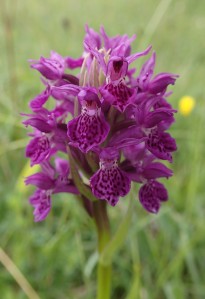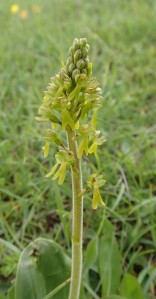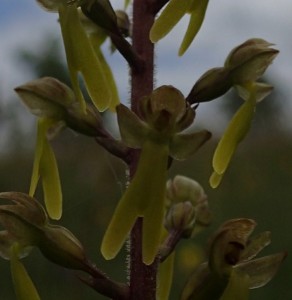I feel I need cheering up after Thursday’s referendum result so have squeezed in a couple of visits to Thrislington NNR this week. It looks quite different to when I visited at the beginning of the month . Then the meadows and, especially, the woodland areas were dominated by the deceitful Early purple orchid, Orchis mascula. Now the meadows, in particular the ungrazed ones, are a sea of paler purple Dactylorhiza fuchsii – it’s clear why its called Common spotted orchid!

Dactylorhiza fuchsii
A few Northern marsh orchids stand out, distinguished by their rich, dark purple colour (hence the latin name, D. purpurellla) and the much less divided lower lip of the flowers.

D. purpurella
We know there are Heath-spotted orchids (D. maculata) here, but they are difficult to spot amongst the common spotted ones. Dactylorhizas hybridise like mad, so there are almost certainly intermediate forms around too.
Once we get our eyes in, we see many delicate green Common twayblades, Listera ovata.

Listera ovata
I can’t help thinking that the flowers look a bit like Teletubbies….

The next orchid we find is a bit of a mystery.

Initially we think they are helleborines of some sort but the flowers are not right for this – they are rather like twayblade flowers. Instead of the single pair of basal leaves which give the twayblade its name, however, these plants have leaves up the stem. In the end, we decide they are probably Frog orchids, Coeloglossum viride.
In the furthest meadow we do find helleborines though – the colony of Dark-red ones (Epipactis atrorubens) which are one of the special features of the site. At the moment the statuesque flower heads are drooping and still in bud but promise good things to come in a week or two.

Epipactis atrorubens
Of course it’s not all about orchids – the site is amazingly diverse. We saw rock roses, perennial flax, zig-zag clover, milkwort, quaking grass, thyme, yellow rattle, ladies bedstraw, burnet rose, eyebright, salad burnet and agrimony in flower, as well as all the usual grassland suspects. Not bad for an area of magnesian limestone grassland, part of which was translocated from above the neighbouring quarry around 20 years ago!
The rich flora is good news for pollinators and seeing small blue butterflies is a rare treat in this part of the world. These were far too quick for my camera but at least this lovely Durham argus butterfly (Aricia artaxerxes salmacis) kept still for us.






[…] had grown noticeably further across the path in the two days between my orchid-hunting visits to Thrislington on 25th and 27th June. My legs bear the […]
[…] of Dark-red helleborines (Epipactis atrorubens), and Blue moor grass (Sesleria caerulea), (see More Thrislington Orchids for 30 Days wild) but also has a wide range of other plants of calcareous grassland – cowslips, rock roses, flax […]
[…] so far. I’ve noticed before how well purple and yellow flowers complement each other – at Thrislington NNR it’s Cowslips and Early-purple Orchids in May. Here it is Meadow Buttercups, Cat’s-ear, Wood […]
[…] Early-purple orchids are a favourite, for their early appearance, Pyramidal orchids are another, for their cosmopolitan distribution. I’ve seen their dense pink […]
[…] parts of the Thrislington nature reserve which I’ve written about before, the grassland here is relatively undisturbed and lies on […]
[…] species-rich grassland similar to that in other nearby quarry reserves such as Bishop Middleham and Thrislington. I was more surprised to see common heather, Calluna vulgaris, and puffballs growing on the well […]
[…] from us, at Cassop. I’ve never visited before, drawn by the allure of larger, and more famous national nature reserves not much further away. On a bitterly cold, late March afternoon the site initially looks […]
[…] here – the list of obvious species is similar to that at nearby Crowtrees, Raisby Hill and Thrislington reserves; Carline thistles, Orchids, Scabious, Knapweed, Yellow rattle, Fairy flax, Wild thyme and […]
[…] requested a ‘visit to a quarry’ so on Saturday we made our first trip of the year to Thrislington NNR on a warm, sunny morning which felt like the start of summer. The Cowslips, Bluebells and […]
[…] nature reserves and, indeed, we found it later in the week on a mooch round Bishop Middleham and Thrislington. I’d feared most of the flowers would be over but there were many lovely things still to see. […]